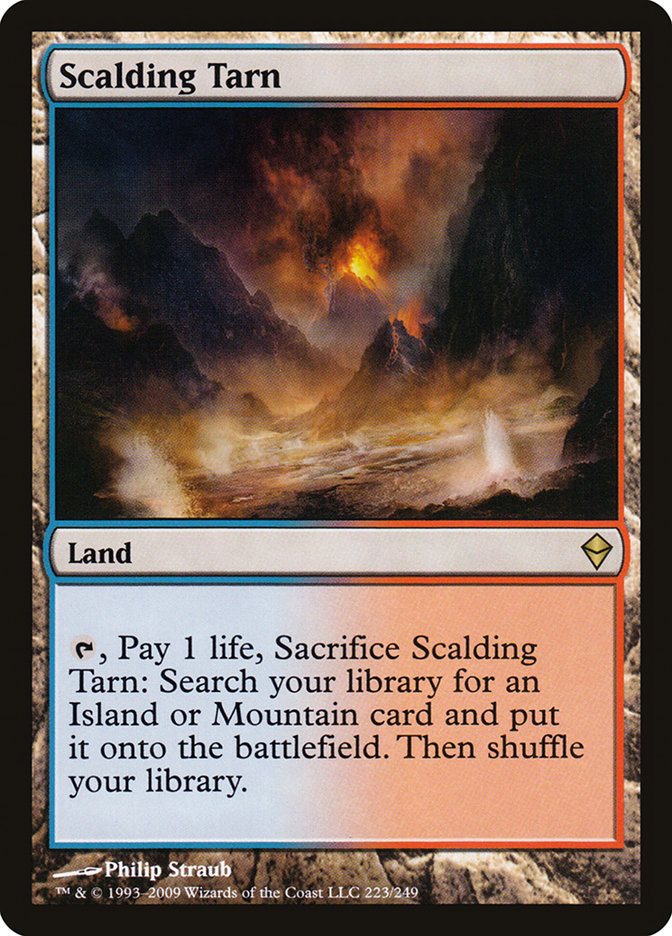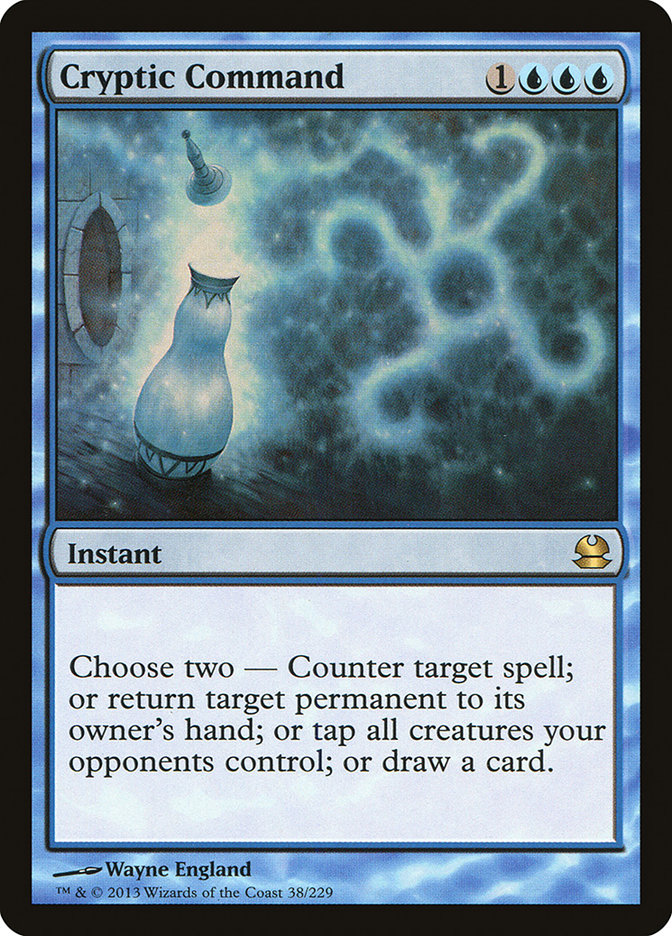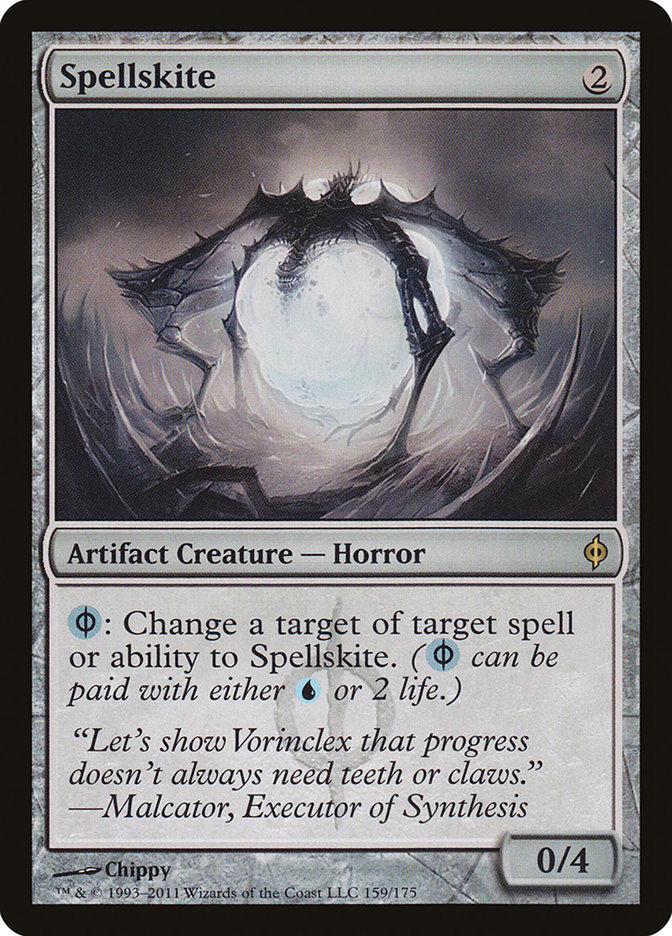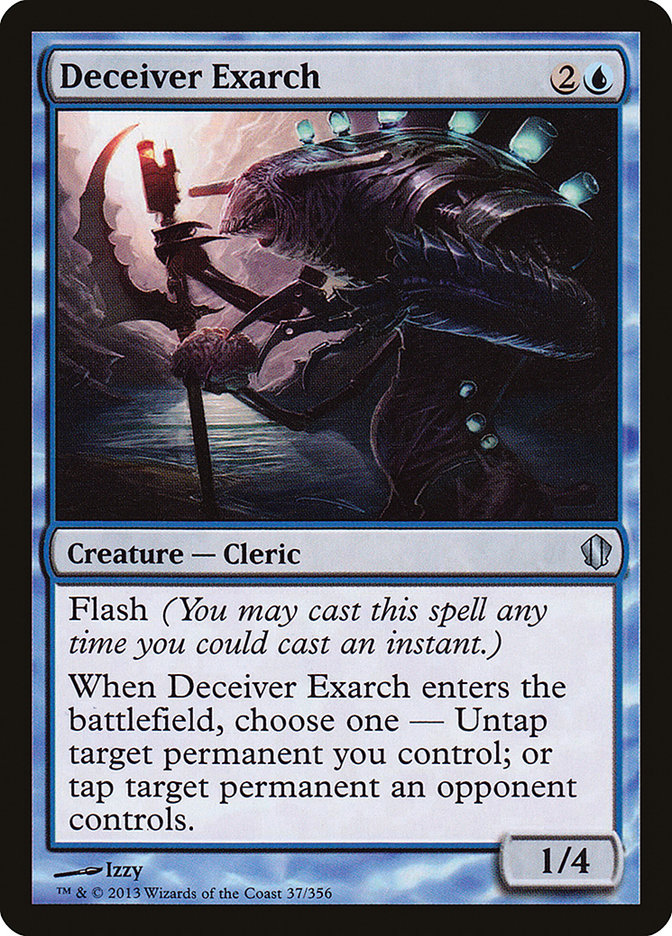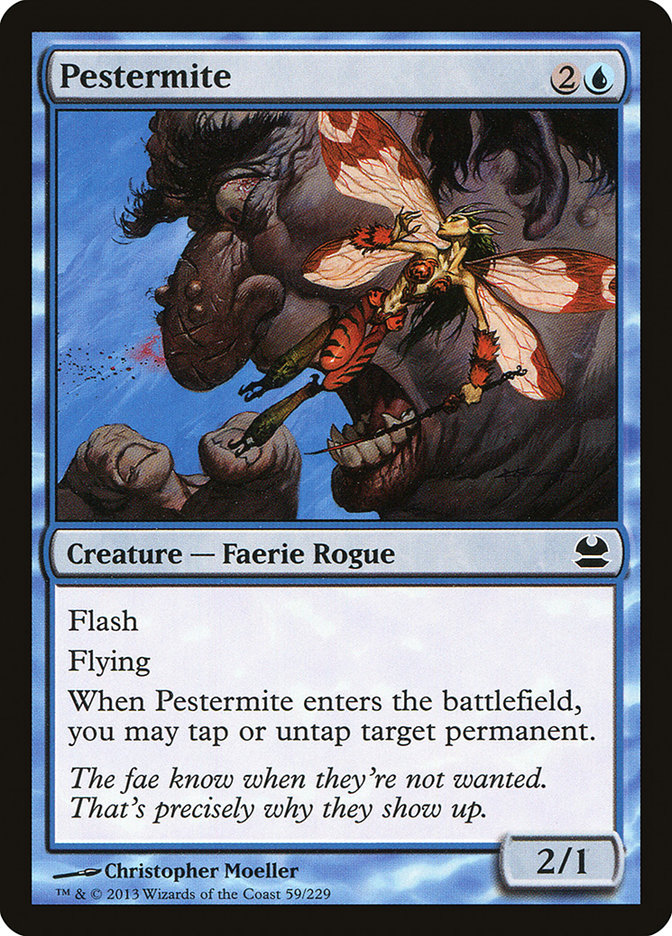The Modern Open last weekend in Baltimore hit really high attendance numbers. Regardless of how people feel about the state of the Modern format, it’s
clear that people were excited to actually go out and play it last weekend.
While Modern doesn’t have nearly the same wealth of crazy interactions as Legacy does, there are still a number of interesting situations that will come up
when playing with and against some of the most popular decks. There are a number of ways to maximize those interactions and avoid getting blown out in the
process.
If you are looking to get into Modern, or even just improve your understanding of one of Magic’s most popular formats, it’s a good idea to understand how
to play with and around these cards and situations. Knowing exactly how to navigate these kinds of scenarios that come up time and time again but aren’t
necessarily obvious to understand is one of the biggest differences between a successful and unsuccessful Modern player.
Former Standard all-star Remand has made just as much of a mark on Modern as it did in Standard years ago. Remand was often referred to as a “Time Walk”
when it was legal in Standard, and while it isn’t nearly as good in a format where people have access to a lot of cheaper and more powerful spells, it
still does a lot of work.
There are a number of interesting interactions and ways to extract extra value out of this card, and I want to cover some of them.
The first interesting interaction with Remand is that in matchups where both players have a lot of countermagic, the most common use of Remand is to
actually use it on your own spells. While that seems counterproductive in theory, in practice it ends up being very advantageous.
To give an example, let’s say you cast a big, important spell like Scapeshift. Your opponent needs to counter it or they will die. They’ll fire off
something like a Cryptic Command to counter it and draw a card. Rather than just Remand their Cryptic Command and let them cast it again on your
Scapeshift, what you can instead do is just Remand your own Scapeshift. You get to draw a card, and it will actually counter their Cryptic Command (since
it no longer has a legal target) meaning they don’t even get to draw a card off of it. You get to draw a card, and you still have the Scapeshift to cast
again next turn. You end up way ahead on the exchange.
Splinter Twin mirror matches often come down to grinding out little advantages like this. You cast a Deceiver Exarch, they try to Remand it, and then you
Remand your own Deceiver Exarch. You draw a card, and they lose their Remand and don’t draw a card off of it. These little incremental advantages will
consistently push you more and more ahead until you can convert it into a win.
Another good interaction with Remand is to use it to counter a spell like Living End. If your opponent casts a Demonic Dread or Violent Outburst, they are
going to cascade into Living End. If you Remand the Living End, it goes back to their hand, where it is now effectively useless. Plus you get to draw a
card out of the mix. One important thing to note is that they still get to cascade even if you counter the Demonic Dread or Violent Outburst, and it is
rarely correct to do so.
Remand is also great against Flashback spells. When you Remand a Flashback spell, it still gets exiled and does not go back to the hand. Generally
speaking, when your opponent casts a Snapcaster Mage and you have a Remand, you can let the Snapcaster resolve and then just Remand the spell they try to
Flashback. They end up with just a 2/1 creature, and you’re up a card. It’s a pretty even exchange, but there is no shame in breaking even on a Snapcaster
Mage, as I consider Snapcaster the best card in Modern.
In one Splinter Twin mirror I played in Baltimore, the following interaction took place: I cast a Snapcaster Mage and flashed back an Electrolyze. My
opponent Remanded my Electrolyze, and then I proceeded to Remand my own flashbacked Electrolyze. When the dust settled, I got to draw a card and had a 2/1
Snapcaster Mage in play, and my opponent was down a Remand without getting to draw a card. It wasn’t particularly advantageous for each of us, but denying
your opponent value in that matchup is integral to winning.
In Legacy, it’s important to save fetchlands as long as you can, because having access to a shuffle effect improves the value of cards like Brainstorm. In
Modern, the same is not true. There are not many played cards that make holding up a shuffle effect valuable, and there are actually cards that can make it
detrimental.
One example is Serum Visions. If you cast a Serum Visions and find two cards that you want to scry to the top, having fetchlands can actually make things
awkward, as you are put into the unenviable situation of either being down mana until you draw both cards, or being forced to shuffle them away to cast a
spell when you need to crack a fetch. As a result, it’s generally correct to fetch as early as possible to make Serum Visions better.
That’s why you sometimes end up seeing plays like a player on turn 2 cracking a fetchland to put a Steam Vents into play tapped, and then casting a Serum
Visions with their other land afterward. They avoid taking damage from the shockland and get to crack their fetch to improve the value of the Serum Visions
if they want to keep the cards on top. This might seem like a marginal advantage, but it actually comes up fairly regularly.
Another common line of play in Modern is to crack fetchlands at the end of your opponent’s turn if you end up not needing to utilize the mana. This lets
you find a Ravnica shockland, like Steam Vents, and avoid taking damage from it. Maximizing your fetchland usage to reduce the damage taken over the course
of a game can mean the difference between a lot of wins and losses in a Modern event.
One fringe situation that comes up from time to time and is extremely important to remember with fetchlands is that green fetches like Misty Rainforest or
Verdant Catacombs are actually able to search out Dryad Arbor. This becomes relevant a lot of the time against decks like G/W Hexproof or Infect: They can
search up a Dryad Arbor to play around Liliana of the Veil’s -2 ability. G/W Hexproof can also use Dryad Arbor as an offensive threat that doesn’t die to
Abrupt Decay against decks that rely on Decay as their primary removal option.
Cryptic Command is one of the most powerful cards in Modern, but it is also one of the most confusing. There are a lot of weird rules interactions with
Cryptic Command, and having a complete understanding of the card can prevent a lot of avoidable situations from costing you games.
One important interaction to remember with Cryptic Command is that the spell can either have zero, one, or two targets, depending on the modes chosen. This
is important to remember, because if a spell has only a single target, and that target becomes an illegal target before the spell resolves, the spell will
be countered upon resolution.
To provide an example, let’s say you cast a Cryptic Command choosing to bounce an Arcbound Ravager and draw a card. That spell only has one target, the
Arcbound Ravager. If your opponent sacrifices their Arcbound Ravager to itself in response, Cryptic Command no longer has a legal target and will be
countered. That means the entire spell is countered, including the draw a card part.
Let’s say, however, that you cast a Cryptic Command choosing to counter a Steel Overseer and also bounce an Arcbound Ravager. If your opponent sacrifices
the Arcbound Ravager to itself, the Cryptic Command is still going to resolve, because it still has a legal target in countering Steel Overseer. Both the
Steel Overseer and Arcbound Ravager would need to become illegal targets to counter a Cryptic Command with these modes.
Cryptic Command with the modes “Tap all creatures your opponents control” and “Draw a card” has no targets, and thus the only way to counter that ability
is to have an actual counterspell.
Another area where Cryptic Command can create confusion is in regards to the tap all creatures your opponent controls ability. Creature lands like Inkmoth
Nexus and Treetop Village are good foils to this kind of ability. The best way to play around a Cryptic Command when you suspect your opponent has one is
to announce your intention of going to combat before activating your land into a creature. If they cast a Cryptic Command to tap your team and draw a card,
you can then activate something like a Treetop Village afterward and still get an attack out of it.
It’s important to note that if you announce you’re going to your attacks and your opponent gives you the okay, it is now too late to activate a land like
Treetop Village or Inkmoth Nexus. It’s not really possible to get the best of both worlds against Cryptic Command. Generally you are either attacking with
your non-land creatures or only your lands, but not both.
The Cryptic Command player can also play around these creature lands by casting Cryptic Command to tap all creatures and also bounce the offending land.
“Tap all creatures and bounce your Treetop Village” generally is good enough to prevent yourself from taking any damage that turn.
However, that line of play doesn’t come without risk. Casting Cryptic Command as “Tap your creatures and bounce Inkmoth Nexus” has only a single target,
and if your opponent protects their Inkmoth Nexus with something like a Vines of the Vastwood, it will actually completely counter the Cryptic Command,
meaning you don’t get to tap their creatures either. Decks with Treetop Village can also foil this with something like activating the Treetop Village and
casting a removal spell on it or even just blowing it up with a Tectonic Edge.
As you can see, Cryptic Command is a very difficult card to play with and against, and can create a lot of complicated and non-intuitive game situations. I
can’t imagine how many times Cryptic Command has been resolved illegally without the players realizing it since it came out in Lorwyn, but I figure it has
to be pretty high. Knowing exactly how this card works is very important to being a competent Modern player.
Another way to play around Cryptic Command is to try to avoid casting creatures in your first main phase as often as you can. Let’s say you have a
Tarmogoyf in play and access to four mana. If you cast a Siege Rhino in your first main phase, your opponent can cast Cryptic Command as “Counter your
Siege Rhino and bounce your Tarmogoyf,” and you’re left without a board, and you didn’t get to attack. If instead you attack with Tarmogoyf and then cast
the Siege Rhino in your second main phase, you at least get some damage out of the deal.
Playing with Cryptic Command also offers a number of perks. It is one of the most versatile cards, if not the most versatile card, in Magic’s history.
Oftentimes you want to save Cryptic Command to counter something juicy and draw a card out of the mix, but sometimes it is actually just correct to blow
your Cryptic Commands as soon as possible on whatever you can.
In matchups like Jeskai Control versus Splinter Twin, a matchup where hitting land drops is very integral to winning the game, it’s often correct for the
Jeskai Control player to just fire off their Cryptic Commands at the end of the Twin player’s turn to bounce a land and draw a card. While that may seem
like a complete waste, this kind of a tempo play is actually pretty key to Jeskai gaining an edge against Twin. That line of play will cause the Jeskai
Control player to pull ahead on land drops, not lose any card advantage, and also get rid of an expensive and clunky card like Cryptic Command that can
often be very hard to use advantageously against a deck packing cheap and effective countermagic like Dispel and Remand.
Another awesome line of play is to use Cryptic Command to bounce Snapcaster Mage. If your opponent casts a spell you want to counter, you can use Cryptic
Command to counter that spell and bounce your own Snapcaster Mage. Rather than just draw a random card with Cryptic, you instead get to effectively draw a
Snapcaster Mage, which will oftentimes then proceed to just Flashback that Cryptic Command on the next important spell your opponent plays anyway.
Lastly, Cryptic Command can be a great way to take care of a Liliana of the Veil when both players are low on resources. If your opponent has no cards in
hand and ticks up a Liliana of the Veil, you can use Cryptic Command to bounce it in response to the ability, and they are now forced to discard their
Liliana of the Veil to its own ability. I’m not sure how that works on the flavor judge scale, but it feels like justice to me.
Another commonly played Modern card is Spellskite. Spellskite offers a powerful line of defense against a variety of decks. Against G/W Hexproof, you can
redirect all of their auras to your Spellskite, making it nearly impossible for them to do anything. Against Infect, you can do the same thing with their
pump spells, and since they don’t care about real damage, you can even get away with paying a bunch of life to do so. Spellskite also blanks Splinter Twin
(the card) against Splinter Twin (the deck). If they try to cast a Splinter Twin on a Pestermite, you can just redirect it to the Spellskite.
There are a number of interesting interactions with Spellskite. One oddball interaction actually came up on camera at the Baltimore Open. One player had
access to a Lightning Bolt and a Remand with the opponent tapped out at three life with a Spellskite in play. What the Lightning Bolt player can do in that
situation is to fire off the bolt at the opponent. When the opponent pays two life to redirect the Lightning bolt to Spellskite, dropping to one life, the
player can then Remand their own Lightning Bolt and then cast it again for lethal.
Weird situations like that don’t generally come up too often, but what does happen frequently is the interaction between a card like Spellskite and
Electroylze. Spellskite is able to redirect the damage from Electrolyze to itself, however, that doesn’t apply when Spellskite is already one of the
targets of Electroylze. Let’s say you have an Electrolyze and your opponent has a Spellskite and a Grim Lavamancer. If you cast the Electrolyze to deal one
damage to your opponent and one damage to the Grim Lavamancer, your opponent can redirect the damage aimed at Lavamancer to the Spellskite and save their
creature or they can redirect the damage aimed at them to Spellskite and save a point of life, but not both.
When a spell or ability is cast with multiple targets, Spellskite can’t redirect all of those targets to itself. Therefore, if you deal one damage to the
Grim Lavamancer and one damage to the Spellskite, your opponent can no longer use Spellskite to save the Grim Lavamancer. Since the Electrolyze is cast
choosing two targets and splitting up the damage between them, Spellskite can’t redirect the damage from both targets to itself. Spellskite is already one
of the targets, therefore, it can’t also be the other target.
So in a situation where your opponent is at one life and they have a Spellskite in play and a blue mana open, if you cast Electroylze to deal one damage to
the Spellskite and one to them, they will die. They can’t redirect the damage targeting them to Spellskite, since it is already a target of the spell. If
you cast Electrolyze simply targeting them for two damage, then Electrolyze will only have one target and they can redirect it to Spellskite.
Another interesting interaction with Spellskite is that you can use it to redirect the modular ability from your opponent’s Arcbound Ravager, since
Spellskite is also an artifact creature. This actually comes up reasonably often against a deck like Affinity, where you can block an Etched Champion all
day with Spellskite, even if they have access to an Arcbound Ravager. If they try to move counters to Etched Champion, you can simply redirect them. It’s
important to note that Arcbound Ravager’s ability is a “may” ability, so they are not required to actually put the counters on Spellskite. It’s really nice
when they choose to do so though!
The Infect deck can actually make use of Spellskite in a unique way. With two copies of Spellskite in play and a Wild Defiance, they can actually bounce a
spell back and forth between the two copies of Spellskite and grow their two Spellskites by +3/+3 each time they do it, thanks to how Wild Defiance works.
It’s a pretty weird interaction, but it does come up from time to time.
The last weird interaction with Spellskite is that you can actually try to redirect any ability with a target to Spellskite, even if Spellskite isn’t a
legal target for that ability. The spell or ability won’t be redirected to Spellskite, but this can be relevant in a few ways. For example, if you
Mindslaver your opponent and they control a Spellskite, you can do something like redirect an Academy Ruins activation to Spellskite over and over and over
again until suddenly they are at zero life. Convenient. You can also abuse this ability yourself to put yourself to low life totals, something that can be
relevant with fringe cards like Death’s Shadow.
Vines of the Vastwood is the powerful protection and pump spell that Infect gets access to. It can serve as a way to protect your creatures from removal
spells and also give them +4/+4 in a pinch. It’s a powerful and versatile spell, and without it, Infect would likely not be a viable deck.
The cool thing about Vines of the Vastwood is that it can actually do so much more than that. The way Vines of the Vastwood works is that it gives its
target protection from spells and abilities your opponent’s control. What makes it unique is that unlike most other similar spells, you can actually target
your opponent’s creatures with it. This becomes relevant in a number of situations.
The first situation is with Splinter Twin. If your opponent casts a Splinter Twin targeting a Pestermite, casting a Vines of Vastwood on the Pestermite
will actually give it protection from spells or abilities your opponent’s control, which in this case means Splinter Twin. The Splinter Twin will no longer
have a legal target and won’t resolve. Before Mizzium Skin was printed, Twin decks actually used to splash green for Vines of Vastwood themselves to
protect their creature from removal, and also fight the mirror.
This is also pretty clutch in the Infect mirror match. You can use a Vines of Vastwood to target one of your opponent’s creatures in response to a lethal
pump spell from them, countering the spell entirely. I have to imagine that every time someone successfully pulls this off, their ego becomes immense.
This can also be relevant against decks like G/W Hexproof when they are putting enchantments on a creature that doesn’t have hexproof or even against a
deck like Amulet Bloom when they are trying to give their Primeval Titan +2/+0 and haste with a Slayer’s Stronghold.
While we’re on the topic of Infect, another card with hidden modes is Apostle’s Blessing. Not only can it give a creature protection from a color, but it
can also give protection from artifacts, which is pretty relevant against the Affinity deck and opposing copies of Inkmoth Nexus.
Blood Moon is one of the most hateful cards in Modern, right up there with things like Choke and Ghostly Prison. Sometimes an early Blood Moon can simply
lock your opponent out of the game and prevent them from ever casting another spell. Generally speaking, if you think your opponent has access to Blood
Moon, it’s usually correct to fetch some early basic lands to play around it.
There are a few interesting interactions with Blood Moon and how it interacts with cards. Dryad Arbor, for example, is still a 1/1 creature with a Blood
Moon in play, but it is also a Mountain and taps for red mana. I have to imagine these kinds of easily intuitive situations are exactly what Richard
Garfield had in mind when he designed the game. Or…you know…probably not.
Another common interaction is the one between Blood Moon and Spreading Seas. In the case of these two cards, it comes down to timestamps to determine which
effect overrides the other. So if you have a Blood Moon in play and a Spreading Seas on an opponent’s nonbasic land, it is going to depend on which
happened first as to whether it is an Island or a Mountain. The easy way to remember this is that the most recent effect reigns supreme. If you cast a
Blood Moon first and then a Spreading Seas, it’s an Island. If the Spreading Seas was already in play when you cast Blood Moon, it’ll become a Mountain.
If the Spreading Seas is on a basic land, then Blood Moon doesn’t have an effect and the land is just a plain old boring Island. Lame.
This isn’t a particularly complex interaction, but it is one that is forgotten quite often, including by myself at the Pro Tour when I played against
Affinity. Cranial Plating costs a single colorless mana to equip, but it also has the ability that it can be moved to a different creature at instant speed
by playing two black mana. Thanks to cards like Springleaf Drum, Glimmervoid, and Mox Opal, Affinity can actually produce two black mana fairly easily.
It’s important to watch out for and play around the ability for your opponent to shift their Cranial Plating around after important things like blocks have
already been declared. You aren’t always safe letting a zero power Ornithopter through unblocked.
Deceiver Exarch and Pestermite serve as one half of the Splinter Twin combo. You cast one of these innocuous creatures and then you slap a Splinter Twin on
them and suddenly you have an arbitrarily large number of faeries or clerics that are all hasty and ready to finish off your opponent immediately.
However, in addition to being part of an infinite combo, these creatures actually are pretty good at providing a lot of annoying disruption over the course
of a game.
One example is that you can use Deceiver Exarch or Pestermite to untap a Grim Lavamancer or Izzet Staticaster and get a second activation out of it,
assuming you have enough mana to pull it off. You can also use a Deceiver Exarch or Pestermite to likewise tap down your opponent’s copy of the card in
response to a Splinter Twin to prevent them from being able to combo off that turn.
Deceiver Exarch and Pestermite can also just serve as great tempo plays. On turn 3, you can jam a copy of one of these cards and tap down one of your
opponent’s lands in their upkeep. Sometimes this can seriously restrict their options or even just completely ruin their turn.
You can also use them to untap your own permanents, meaning you can do nifty things like untap a land to provide mana for a counterspell or even something
like a Serum Visions. You can also untap another creature to give you access to an additional or even surprise blocker. Lastly, if you start to combo off
and your opponent casts something like a Celestial Purge to destroy your Splinter Twin, you can actually cast another Pestermite or Deceiver Exarch to
untap the original creature in response and start the combo again in response to their Purge. Blowout.
One thing to remember is that Deceiver Exarch is actually weirdly worded such that it either taps one of your opponent’s permanents or untaps one of your
own. You can’t tap your own permanents nor untap your opponent’s. This also means that if you target one of your own permanents to untap, your opponent
actually can’t redirect that ability to Spellskite. They can pay the life and try, but it doesn’t do anything. Old Splinter Twin decks used to actually be
able to combo through a Spellskite by using Deceiver Exarch and Kiki-Jiki, Mirror Breaker, two abilities that couldn’t be redirected to the Skite.
Modern is full of a ton of weird and interesting interactions, many of which aren’t very obvious to understand. This is only just the tip of the iceberg.
There are so many other things, like how you can look at your opponent’s sideboard when you Mindslaver them, or how you can blow up two lands with Tectonic
Edge when your opponent only has four in play, or activate Raging Ravine multiple times to get extra counters when it attacks. There are so many little
tips and tricks, and I learn more and more every time I play the format. Being able to understand and capitalize on all the little idiosyncrasies of the
format is actually pretty integral to being successful at Modern. While it may seem like “Legacy Lite” to many players, Modern actually offers a lot of
room for skillful maneuvering and a lot of options to gain an edge on your opponents. Hopefully this provides a solid starting point to let you take
advantage of this, and to not be the one taken advantage of. Nobody wants that.



